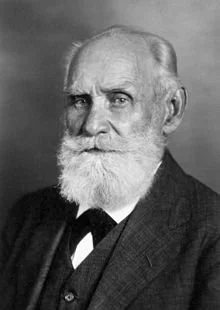WORLDWIDE REFLEXOLOGY HISTORY
1900 - 1914
Vladimir Bekhterev Ivan Pavlov Sir. Charles Sherrington Dr. W. Fitzgerald Edwin Bowers
Dr. Algien Benedikt published his book in Germany in 1902 "On Neuralgia and Neurologic Effects, Questions of Clinical Treatment and Clinical Problems.”
Dr. Alfons Cornelius, who found support for his theories in the publications of Dr. Otto Naegeli “Treatment and Healing of Nervous Suffering and Nervous Pain by Hand Manipulation” and that of Dr. Algien Benedikt “On Neuralgia and Neurological Effects, Questions of Clinical Treatment and Clinical Problems”, published in Germany in 1902 “Druckpunkte” or “Pressure Points, Their Origin and Significance”. He would only teach fellow physicians his “nerve massage” techniques.
Dr. Vladimir Bekhterev in Russia, published a book “Psyche and Life,” written in 1902, which contained multiple volumes including “Foundations for Brain Functions Theory” written in 1903. “Foundations for Brain Functions Theory” described Bekhterev's views on the functions of the parts of the brain and the nervous system.
Dr. William H. Fitzgerald was present in Vienna in 1902 – so, he was likely aware of the preceding publications of Dr. Vladimir Bekhterev, Dr Algien Benedikt and Dr. Alfons Cornelius.
In 1904 in Russia, Dr. Ivan Pavlov, carried out experiments on the digestive glands, as well as investigated the gastric function of dogs, and eventually won the Nobel Prize for Physiology or Medicine. Pavlov contributed to many areas of physiology and neurological sciences. Most of his work involved research in temperament, conditioning and involuntary reflex actions. Pavlov's principles of classical conditioning operate across a variety of behavior therapies and in experimental and clinical settings, such as educational classrooms and even reducing phobias with systematic desensitization.
In 1906, nobel prize winner, Sir Charles Sherrington in England published his classic work “The Integrative Action of the Nervous System”. He proved that stimuli are produced within the organism by movements in its own tissue, and that the essential function of the nervous system was to coordinate the activity of various parts of the organism. He called this the proprioceptive system. Sensory receptors in our joints, muscles, and skin work together to build body awareness.
In 1907, Dr. Vladimir Bekhtereva published in Russia “Objective Psychology” – translated into French & German in 1913, and English in 1932 with the revised title “General Principles of Human Reflexology.” He is known for his competition with Ivan Pavlov regarding the study of conditioned reflexes.
Around 1909, Dr. William H. Fitzgerald claims to discover zone therapy. In his book he writes “ Six years ago I accidently discovered that pressure with a cotton-tipped probe on the muco-cutaneous margins (where the skin joins the mucus membrane) of the nose gave an anesthetic result as though a cocaine solution had been applied. I further found that there were many spots in the nose, mouth, throat, and on both surfaces of the tongue which, when pressed firmly, deadened definite areas of sensation…………..This led to my ‘mapping out’ these various areas and their associated connections, and also to noting the conditions influenced through them. This science I have named zone therapy.”
According to Herman Kamenetz in his book “History of Massage” a German physician, Dr. Barczewski introduced in 1911 a similar technique to that of Dr. Alfons Cornelius, calling it “Reflexmassage”.
In 1913 in Japan, psychologist Dr. Kurakichi Hirata divided the body into horizontal zones – a system of seven regions of the body, that are again divided with twelve zones.
In 1914, Dr. Arsende d’Arsonal, a French physician, published in Germany “The Future of Medicine” in which he predicts that the future of medical therapies will entail the use of heat, light and electricity, not drugs. According to Dr. W.D. Chesney in “Zone Therapy Is Scientific.” Dr. d’Arsonal used PhysioTherapy to get relief following the use of reflex knowledge.
In 1915, in the U.S.A., Dr. Edwin Bowers published an article in Everybody’s Magazine in the U.S.A. entitled “To Stop That Toothache, Squeeze Your Toe” – bringing the work of Dr. William Fitzgerald to the public for the first time.




